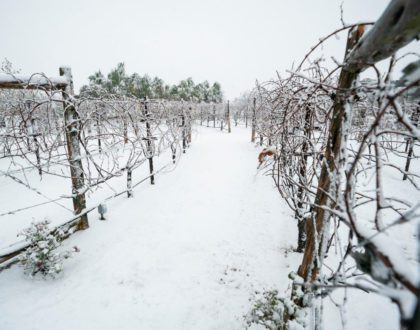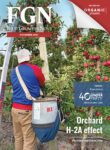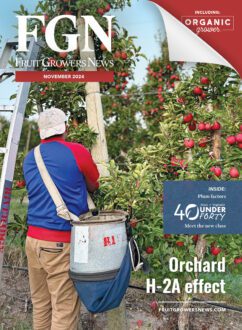Winter Storm Uri, which blasted through the entire state of Texas, caused at least $600 million in agricultural losses, according to preliminary data from Texas A&M AgriLife Extension Service agricultural economists.
“A large number of Texas farmers, ranchers and others involved in commercial agriculture and agricultural production were seriously affected by Winter Storm Uri,” said Jeff Hyde, Ph.D., Texas A&M AgriLife Extension Service director, Bryan-College Station. “Freezing temperatures and ice killed or harmed many of their crops and livestock as well as causing financial hardships and operational setbacks. And the residual costs from the disaster could plague many producers for years to come.”
AgriLife Extension estimates of some of the state’s biggest agricultural losses by commodity were:
— Citrus crops: At least $230 million.
— Livestock: At least $228 million.
— Vegetable crops: At least $150 million.
Another agricultural sector that experienced significant losses was the green industry. AgriLife Extension, in collaboration with the Texas Nursery and Landscape Association, developed and distributed a loss assessment survey to more than 4,000 nursery, greenhouse and other green industry-related businesses requesting input on the type and extent of losses encountered. It will be several weeks before there is sufficient data to provide an assessment of those losses.
How agricultural losses were estimated
“The data we used to determine these agricultural losses came from farmers, ranchers and other commercial producers throughout the state as well as others involved in or supporting production agriculture in Texas,” said Mark Waller, Ph.D., associate head of Texas A&M University’s Department of Agricultural Economics, Bryan-College Station.
Monty Dozier, Ph.D., AgriLife Extension program director for disaster assessment and recovery, said the data related to agricultural losses was acquired through the agency’s extensive statewide network of agents and specialists.
“Our people collaborated with agricultural industry groups and other stakeholders to get the most accurate and up-to-date information available at this time,” Dozier said. “Then the information was assembled and analyzed by agricultural economists and other agricultural experts from Texas A&M AgriLife using a standardized approach.”
Waller said currently the agency can only provide a general range of loss or estimated overall loss for the state’s agricultural sectors.
“There are still many as yet unknown and lingering effects of Winter Storm Uri,” he said. “What we can say is these figures are conservative and we expect more losses as a long-term effect of this disaster.”
The citrus situation
“The Texas agricultural sector that suffered one of biggest overall losses from Winter Storm Uri was the citrus industry,” said Luis Ribera, Ph.D., AgriLife Extension economist, Bryan-College Station.
Ribera said citrus producers in the Rio Grande Valley lost virtually all of their Valencia orange crop and more than 60% of their grapefruit crop.
“Even more citrus crops would have been lost had many not been harvested before the storm,” he said.
Ribera said the AgriLife Extension estimate for citrus losses came out to around $230 million and was based primarily on losses in the Rio Grande Valley during the storm.
“That estimate also included longer-term losses from next year’s crops, but it did not include the cost of citrus plants that could die or remain badly damaged by the freeze and have to be replaced,” he said. “If they must be replaced, it will be several years before those new citrus trees are able to bear fruit, so the losses could be much more.”
Juan Anciso, AgriLife Extension horticulturist based at the Texas A&M AgriLife Research and Extension Center in Weslaco, said about 200 acres of lemons and limes produced in South Texas were destroyed completely because those plants were more sensitive to cold weather than other types of citrus.
“If those producers choose to replant, it will be three to five years before those new plants will begin to yield fruit,” Anciso said.
Ribera said while the effects of the storm likely will impact grapefruit availability and prices in the future, it probably won’t have a significant impact on orange prices due to large supplies available from Florida and California.
Other crops blasted by freezing weather
Along with their citrus losses, Rio Grande Valley and other South Texas producers also suffered some significant losses in terms of both cold- and warm-season vegetable crops.
Cool-season vegetable crops like leafy greens, beets, cabbage and celery were lost. There were also warm-season crops of potatoes and watermelons planted for early harvest devastated by the freezing weather.
Samuel Zapata, Ph.D., AgriLife Extension economist, Weslaco, said there were notable vegetable losses throughout the area.
“The main vegetable crop damage we saw was to onions, then to leafy greens, including spinach, collard greens and kale, and then to watermelons,” he said.
Zapata said a low estimate based on losses from sales of those and other vegetable crops in that part of the state alone would be at least $150 million.
“Working with the Texas International Produce Association, we estimated a loss of more than $42 million in sales of onions, more than $27 million in sales of leafy greens, more than $20 million in sales of watermelons and more than $15 million in sales of cabbage,” he said. “We also estimated at least another $42 million in additional vegetable and herb sales losses for these large vegetable crop-producing areas. Of course, producers lost vegetable crops in other areas of the state as well, so we determined the $150 million figure to be a minimum.”
Zapata said sugarcane is another major South Texas crop that took a hit from Winter Storm Uri.
“According to the sugar industry, minor damage is expected to the 2020-2012 sugarcane crop given that most of it was already harvested before Uri,” he said “However, a significant drop in yields is expected for next year’s crop as pretty much all cane plants were destroyed and producers will have to start over. It is too early to know the magnitude of the damage.”
According to Mark Welch, Ph.D., AgriLife Extension economist – grain marketing, Bryan-College Station, corn and grain sorghum crops planted in South Texas and the state’s Coastal Bend before the storm will need to be replanted. The cost of this replanting will need to be determined at a later time.
“The most significant grain crop at risk during the storm was wheat, especially wheat that had started to grow,” he said. “But wheat that was still in a dormant state likely survived and will produce.”
He also noted there were statewide losses of livestock grazing materials such as oats, rye grass and triticale, which were included in the estimate.
Assistance for agricultural producers
“While assistance for producers should soon be on the way from the December 2020 COVID stimulus, it’s still too early to tell if the federal government will provide additional targeted assistance in the form of direct disaster relief,” said Bart Fischer, Ph.D., director of Texas A&M University’s Agricultural and Food Policy Center.
However, he said, there are a number of existing programs in place that producers can access, depending upon the problems encountered. By far, the most popular tool is the Federal Crop Insurance Program. For crops with no crop insurance, there is the Noninsured Crop Disaster Assistance Program, or NAP, available through the local Farm Service Agency, or FSA.
The Tree Assistance Program provides cost-share assistance to rehabilitate, replant or clean up damage to orchards and vineyards if trees, vines or shrubs were killed or seriously damaged in a disaster. This is different from NAP or Federal Crop Insurance as these typically cover the crop loss and not plant loss. Producers can reach out to their local FSA office for additional information.”
For information on disaster preparation, assistance and recovery from winter storms, AgriLife Extension offers a number of educational materials through the Texas Extension Disaster Network website.
– Paul Schattenberg, Texas A&M University

















